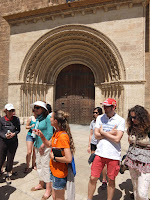It was quite chilly in my room when I wake up at 7 o'clock. The temperature felt like 17 degrees. I made breakfast and prepared myself for another walking.
For this morning I booked an organised tour with Free Tour company. Actually, it is not free, and you have to pay any money you wish at the end of the walking.
With the excursion called "Valencia Essentials" we have visited the popular sights in the city centre - Cathedral, Basilica of the Virgin, Round Square, Silk Exchange and others. The part of the excursion was devoted to visiting the Central Market.
Unfortunately, I could memorise only a few historic facts we were told during the walk. For example, Valencia was founded by Romans in 138 BC, but later it was conquered by Muslims, Christians etc. They claim, that the genuine paella is originated from Valencia, and it consists of beans (white and green), tomatoes, rice, saffron, chicken, rabbit. So, it is called Paella Valenciana. There was also a good piece of advice: not to try paella with snails, because, first of all, it might be quite expensive, and, secondly, it is not so delicious.
Valencia is considered to be the Spain's most Mediterranean city. So, I went to the seashore to check it on my own.
From the city centre you can reach La Arenas by the metro. I used the line 5 from Alameda station, and then at Maritime-Serreria I changed it for another line (Line 6). In fact, this line is a tricky one, because it has different stops in different directions, and you can simply make a loop while getting the stop Les Arenes. However, you can get off at the stops La Cadena, La Marina or Dr. Luch. There is also the tram 8, which leads to the beginning of the marina.
From the city centre you can reach La Arenas by the metro. I used the line 5 from Alameda station, and then at Maritime-Serreria I changed it for another line (Line 6). In fact, this line is a tricky one, because it has different stops in different directions, and you can simply make a loop while getting the stop Les Arenes. However, you can get off at the stops La Cadena, La Marina or Dr. Luch. There is also the tram 8, which leads to the beginning of the marina.
Well, the main beach of the Valencia La Arenas looks enormous. The sand is small here, and it easily sticks to your skin. As it turned out, I also have visited other beaches, including Malva Rosa and Patacona, but I have not understood it right away, because the borders between the beaches are not visible. As a matter of fact, the beaches are spread up in the length of 10 kilometres in Valencia.
At the evening I had another tour called Tapas Tour. We have visited three restaurants with their own tasty traditions. The idea was to get acquainted with the traditions of tapas while drinking and eating some food. Actually, tapa is an appetizer or a small piece of food.
There are several kinds of tapas. You can meet on the menu such words as Plato (dish), Racion (portion), Pintxo (food on a stick).
There are several kinds of tapas. You can meet on the menu such words as Plato (dish), Racion (portion), Pintxo (food on a stick).
The most interesting thing of tapas culture is a free tapa, that you would be offered complimentary while ordering a drink.
Racion is simply a portion of food. Spanish ham, cheese or potatoes is typically served this way. Selecting raciones is a good way to have lunch or dinner with a group of people, and you can eat a little bit of what you most enjoy.
Pintxo is usually a slice of bread with some stuffing on it, and there is a stick in it. The price is mostly all the same, and your bill will depend on how many sticks are left on your plate.
Pintxo is usually a slice of bread with some stuffing on it, and there is a stick in it. The price is mostly all the same, and your bill will depend on how many sticks are left on your plate.
Here is the list of wines I discovered in one of the bars and, probably, it is worth tasting one day:
- Icono syrah;
- Mala vida;- Ribera dul diero.



















No comments:
Post a Comment